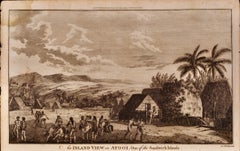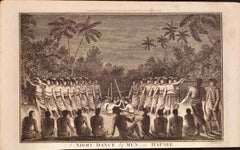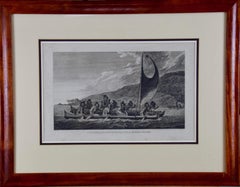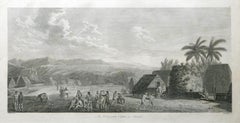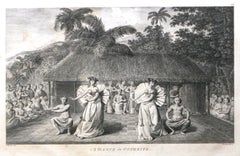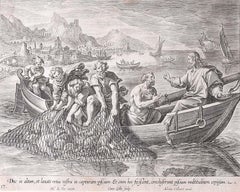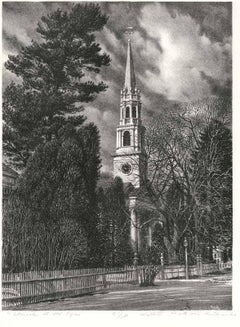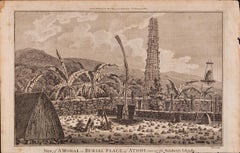John Webber Art
British, 1751-1793
John Webber (1751-1793) was recommended to the Admiralty for appointment as artist for the Captain Cook's 3rd voyage by the Swedish botanist Daniel Carlsson Solander (1733-1782) who had accompanied Cook on his first voyage. Just 24 years old when he joined the Captain Cook’s ship the Resolution at Plymouth one week prior to departure, Webber's skill in both portraiture and landscape resulted in a visual record of Cook's third voyage that is unsurpassed in the annals of 18th century exploration.to
13
25
24
24
23
21
2
1
1
1
A View of Kauai, Hawaii as Seen by Captain Cook: An Original 18th C. Engraving
By John Webber
Located in Alamo, CA
"An Inland View in Atooi, One of the Sandwich Islands (Kauai, Hawaii)" is an original 18th century engraving from a drawing by John Webber (1751-1793), who was the artist who accompa...
Category
1780s John Webber Art
Materials
Engraving
Reception for Captain Cook, Tonga: Original 18th C. Engraving, Cook's 3rd Voyage
By John Webber
Located in Alamo, CA
"The Reception of Capt. Cook in Hapaee" is an original 18th century engraving from a drawing by John Webber (1751-1793), who was the artist who accompanied Captain Cook on his third ...
Category
1780s John Webber Art
Materials
Engraving
A Night Dance by Men in Tonga: An Original 18th C. Engraving, Cook's 3rd Voyage
By John Webber
Located in Alamo, CA
"A Night Dance by Men in Hapaee" is an original 18th century engraving from a drawing by John Webber (1751-1793), who was the artist who accompanied Captain Cook on his third voyage ...
Category
1780s John Webber Art
Materials
Engraving
Sandwich Islands Canoe (Hawaii): Framed 18th C. Engraving Captain Cook's Journal
By John Webber
Located in Alamo, CA
"A Canoe of the Sandwich Islands, the Rowers Masked" is an engraving created by Charles Grignion, from a drawing by John Webber (1752-1793), who was the artist on Captain James Cook's 3rd and final voyage of discovery. It is Plate 65 in the atlas of "A Voyage to the Pacific Ocean Undertaken by the Command of His Majesty, for Making Discoveries in the Northern Hemisphere", the official British Admiralty sanctioned journal published upon completion of the voyage in London in 1784 by Strahan & Cadell.
This famous image of ten Hawaiian rowers transporting a priest who is carrying a feather-covered image of Kukailimoku, the Hawaiian god of war. The priests and paddlers are all wearing gourd masks in their double-hulled canoe with an upright lateen woven sail. Each hull was shaped from a single large Koa log harvested from island rainforests, where they were carved before being transported to the coast.
This engraving is presented in a Koa wood frame and a white mat. There are occasional faint spots, but the print is otherwise in very good condition. Koa is the same wood as was used to make the canoe. Koa wood is legendary in Hawaii. Not only is this amazing wood native to Hawaii, but it is known for the deep rich colors and varied grain pattern. Koa has an honored heritage in Hawaii and is highly revered and sacred. The word “koa” means “warrior” in Hawaiian. The warriors of King Kamehameha the Great, created canoes and weapons from a wood plentiful on the Big Island of Hawaii. This wood became synonymous with the warriors themselves, and it became known as koa. The frame measures 20.75" high, 26.75" wide and 0.88" deep.
There are three other engravings listed from the official journal of Captain Cook's 3rd voyage available that are presented in identical Koa wood frames and mat (LU117324682022, LU117324684052, LU117324684062). They would make a wonderful grouping for a display of 2, 3 or 4 prints. A discount is available for a grouping depending on the number of items included.
Hawaii was discovered by Captain Cook (1728-1779) during this voyage. Hawaii was originally called The Sandwich Islands in honor of The Earl of Sandwich...
Category
1780s John Webber Art
Materials
Engraving
An Inland View; in Atooi ( Hawaii ) 1784 Captain Cook engraving by John Webber
By John Webber
Located in Paonia, CO
An Inland View in Atooi ( Hawaii ) is from the 1784 First Edition Atlas Accompanying Capt. James Cook and King; Third and Final Voyage of Captain James Cook. This engraving depicts ...
Category
1780s Realist John Webber Art
Materials
Engraving
A Dance in Otaheite (Tahiti) 1784 James Cook Final Voyage by John Webber
By John Webber
Located in Paonia, CO
A Dance in Otaheite ( Tahiti ) is from the 1784 First Edition Atlas Accompanying Capt. James Cook and King; Third and Final Voyage of Captain James Cook. John Webber (1752-1793) who...
Category
1780s Realist John Webber Art
Materials
Engraving
Surrender of Tahiti to Captain Wallis: An Original 18th C. Engraving
By John Webber
Located in Alamo, CA
"A Representation of the Surrender of the Island of Otaheite to Capt.n Wallis, by the Supposed Queen of Oberea" is an original 18th century engraving created by Sparrow, from a drawi...
Category
1780s John Webber Art
Materials
Engraving
$200 Sale Price
20% Off
Four Koa Wood Framed 18th C. Engravings from Captain Cook's 3rd Voyage Journal
By John Webber
Located in Alamo, CA
A grouping of four framed engravings of Hawaii, Tahiti, Tonga and Vancouver Island from the atlas of the official British Admiralty sanctioned journal of Captain Cook's 3rd Voyage entitled "A Voyage to the Pacific Ocean Undertaken by the Command of His Majesty, for Making Discoveries in the Northern Hemisphere", published upon completion of the voyage in London in 1784 by Strahan & Cadell. These engravings were made from drawings by John Webber (1752-1793), who was the artist on Captain James Cook's 3rd and final voyage of discovery. The set of engravings includes: "A Canoe of the Sandwich Islands, the Rowers Masked", Plate 65 in the atlas; "A Dance in Otaheite" (Tahiti), Plate 28; "King of the Friendly Islands" (Tonga), plate 20; "Inside of a House in Nootka Sound" (Canada), plate 42.
These engravings are professionally framed in Koa wood, the same wood as was used to make the canoes of the ancient Hawaiians. Koa wood is legendary in Hawaii. Not only is this amazing wood native to Hawaii, but it is known for the deep rich colors and varied grain pattern. Koa has an honored heritage in Hawaii and is highly revered and sacred. The word “koa” means “warrior” in Hawaiian. The warriors of King Kamehameha the Great, created canoes and weapons from a wood plentiful on the Big Island of Hawaii. This wood became synonymous with the warriors themselves, and it became known as koa.
These four engravings would make a wonderful grouping for a display of 2, 3 or 4 prints. They may be purchased separately or in groups on 1stDibs. Their listing Reference #'s are: LU117324682432, LU117324682022, LU117324684052 and LU117324684062. A discount is available for a grouping depending on the number of items included.
Hawaii was discovered by Captain Cook (1728-1779) during this voyage. Hawaii was originally called The Sandwich Islands in honor of The Earl of Sandwich...
Category
1780s Other Art Style John Webber Art
Materials
Engraving
$7,660 Sale Price
20% Off
A Man of Kamtschatka (Russia) 1784 Captain Cooks Final voyage by John Webber
By John Webber
Located in Paonia, CO
A Man of Kamtschatka (Russia) is from the 1784 First Edition Atlas Accompanying Capt. James Cook and King; Third and Final Voyage of Captain James Cook. John Webber (1752-1793) was t...
Category
1780s Realist John Webber Art
Materials
Engraving
A Human Sacrifice, in a Morai, in Otaheite (Tahiti) 1784 James Cook Final Voyage
By John Webber
Located in Paonia, CO
A Human Sacrifice in a Morai in Otaheite (Tahiti) 1784 by John Webber is from the First Edition Atlas Accompanying Capt. James Cook and King; Third and Final Voyage of Captain...
Category
1780s Realist John Webber Art
Materials
Engraving
A Man of Mangea 1784 final voyage of Captain Cook by John Webber
By John Webber
Located in Paonia, CO
A Man of Mangea is from the 1784 First Edition Atlas Accompanying Capt. James Cook and King; Third and Final Voyage of Captain James Cook. John Webber (1752-1793) was the official a...
Category
1780s Realist John Webber Art
Materials
Engraving
A View at Bolcheretzko (Russia) 1784 Captains Cook Final Voyage by John Webber
By John Webber
Located in Paonia, CO
A View at Bolcheretzko (Russia) is from the 1784 First Edition Atlas Accompanying Capt. James Cook and King; Third and Final Voyage of Captain James Cook.John Webber (1752-1793) was ...
Category
1780s Realist John Webber Art
Materials
Engraving
Sedentary Koryaks; Reindeer/Nomad Koryaks
By John Webber
Located in Middletown, NY
Lithograph with hand coloring in watercolor on cream wove paper with a deckle edge, 8 3/4 x 12 1/2 inches (222 x 320 mm); sheet 15 1/4 x 20 7/8 inches (388 x 530 mm), full margins. I...
Category
Mid-19th Century French School John Webber Art
Materials
Watercolor, Lithograph
A Young Woman of Otaheite, Dancing (Tahiti) 1784 Captain Cooks Voyage by Webber
By John Webber
Located in Paonia, CO
A Young Woman of Taheite Dancing (Tahiti) is from the 1784 First Edition Atlas Accompanying Capt. James Cook and King; Third and Final Voyage of Captain James Cook.John Webber (1752-...
Category
1780s Realist John Webber Art
Materials
Engraving
"A Dance in Otaheite" (Tahiti), Engraving from Captain Cook's 3rd Voyage
By John Webber
Located in Alamo, CA
"A Dance in Otaheite" (Tahiti) is an engraving created by William Sharp (1749-1824), from a drawing by John Webber (1752-1793), who was the artist on Captain James Cook's 3rd and final voyage of discovery. It is a plate in the atlas of "A Voyage to the Pacific Ocean Undertaken by the Command of His Majesty, for Making Discoveries in the Northern Hemisphere", the official British Admirality sanctioned journal published upon completion of the voyage in London in 1784 by Strahan & Cadell.
Two women and two men wearing ceremonial costumes, performing a dance outdoors standing on a mat. Three men are playing the drums in the background, in front of a thatched roof building. An audience of men are sitting on both sides of the stage. By the time Webber arrived in Tahiti, 'south sea' imagery had become familiar. Webber gave concentrated attention to dance. He had the opportunity to distinguish the Tahitian dance from the more formalized dancing of Tonga. Whereas they seem to have called to mind the more formal dances of antiquity, the Tahitian dancing aroused memories of peasant and folk dancing.
This engraving is professionally framed in Koa wood. Koa wood is legendary in Hawaii. Not only is this amazing wood native to Hawaii, but it is known for the deep rich colors and varied grain pattern. Koa has an honored heritage in Hawaii and is highly revered and sacred. The word “koa” means “warrior” in Hawaiian. The warriors of King Kamehameha the Great, created canoes and weapons from a wood plentiful on the Big Island of Hawaii. This wood became synonymous with the warriors themselves, and it became known as koa.
The print is in excellent condition.
There are three other engravings listed from the official journal of Captain Cook's 3rd voyage available that are presented in identical Koa wood frames and double mats (LU117324682432, LU117324684052, LU117324684062). They would make a wonderful grouping for a display of 2, 3 or 4 prints. A discount is available for a grouping depending on the number of items included.
Hawaii was discovered by Captain Cook during this voyage. Hawaii was originally called The Sandwich Islands in honor of The Earl of Sandwich...
Category
1780s Realist John Webber Art
Materials
Engraving
$1,900 Sale Price
20% Off
A Sledge of Kamtschatka – An image of a relic from Captain Cook's third voyage
By John Webber
Located in Middletown, NY
London: Scatcherd & Whitaker, 1784.
Etching with hand coloring in watercolor on cream wove paper, 7 1/2 x 10 (190 x 255); sheet 16 1/4 x 22 (414 x 560 mm), full margins. In good cond...
Category
Late 18th Century English School John Webber Art
Materials
Watercolor, Handmade Paper, Etching
"Inside of a House in Nootka Sound" (Canada) from Captain Cook's 3rd Voyage
By John Webber
Located in Alamo, CA
"The Inside of a House in Nootka Sound" is an engraving created by William Sharp (1749-1824), from a drawing by John Webber (1752-1793), who was the artist on Captain James Cook's 3rd and final voyage of discovery. It is Plate 65 in "A Voyage to the Pacific Ocean Undertaken by the Command of His Majesty, for Making Discoveries in the Northern Hemisphere", the official British Admirality sanctioned journal published upon completion of the voyage in London in 1784 by Strahan & Cadell.
This engraving is presented in a Koa wood frame and a white mat. There are occasional tiny faint spots, but the print is otherwise in very good condition. Koa wood is legendary in Hawaii. Not only is this amazing wood native to Hawaii, but it is known for the deep rich colors and varied grain pattern. Koa has an honored heritage in Hawaii and is highly revered and sacred. The word “koa” means “warrior” in Hawaiian. The warriors of King Kamehameha the Great, created canoes and weapons from a wood plentiful on the Big Island of Hawaii. This wood became synonymous with the warriors themselves, and it became known as koa.
There are three other engravings listed form the official journal of Captain Cook's 3rd voyage available that are presented in identical Koa wood frames and mats. They would make a wonderful grouping for a display of 2, 3 or 4 prints. Please see listings: LU117324682432, LU117324684022, LU117324684062. A discount is available for a grouping depending on the number of items included.
Nootka Sound is on the west coast of Vancouver Island, British Columbia, Canada. It was explored by Captain Cook in 1778 after he discovered Hawaii during his 3rd voyage. He originally named it King George's Sound, but did record Nootka Sound, which he thought was its native name. Hawaii was originally called The Sandwich Islands in honor of The Earl of...
Category
1780s Realist John Webber Art
Materials
Engraving
$1,900 Sale Price
20% Off
A Man of the Sandwich Islands, Dancing (Hawaii) from Captain Cooks travels engra
By John Webber
Located in Paonia, CO
A Man of the Sandwich Islands Dancing (Hawaii) is from the 1784 First Edition Atlas Accompanying Capt. James Cook and King; Third and Final Voyage of Captain James Cook. John Webber (1752-1793) was the official artist for the third voyage of Captain James Cook (1728-1779). The purpose of this voyage was to discover the Northwest Passage and to explore the Pacific Ocean north of the Equator. These engravings were published in 1784-85 by G. Nichol and Thomas Cadell of London in the four large format atlas, Voyage to the Pacific Ocean. Captain Cook was an extraordinary explorer known for discovering and mapping unknown territory and for his many contributions to the scientific world. These original engravings from Webber’s drawings and paintings are only a glimpse into this great man’s historical contributions that make him one of the greatest explorers of all times.
This image shows a Hawaiian dancer...
Category
1780s Realist John Webber Art
Materials
Engraving
A Night Dance by Women in Tonga: Original 18th C. Engraving, Cook's 3rd Voyage
By John Webber
Located in Alamo, CA
"A Night Dance by Women in Hapaee" is an original 18th century engraving from a drawing by John Webber (1751-1793), who was the artist who accompanied Captain Cook on his third voyag...
Category
1780s John Webber Art
Materials
Engraving
Kamtschatka, Russia: Engraving by J. Webber from Capt. Cook's 3rd Voyage Journal
By John Webber
Located in Alamo, CA
"A View of the Town and Harbour of St Peter and St Paul, in Kamtschatka" is an engraving created by Charles Grignion, from a drawing by John Webber (1752-1793), who was the artist on...
Category
1780s John Webber Art
Materials
Engraving
"King of the Friendly Islands" (Tonga); Engraving from Captain Cook's 3rd Voyage
By John Webber
Located in Alamo, CA
"Poulaho, King of the Friendly Islands, Drinking Kava" is an engraving created by William Sharp (1749-1824), from a drawing by John Webber (1752-1793), who was the artist on Captain James Cook's 3rd and final voyage of discovery. It was published in the atlas of "A Voyage to the Pacific Ocean Undertaken by the Command of His Majesty, for Making Discoveries in the Northern Hemisphere", the official British Admirality sanctioned journal published upon completion of the voyage in London in 1784 by Strahan & Cadell.
Captain Cook visited Tonga on his 3rd voyage, which he named The Friendly Islands because of the warm welcome he and his crew received, unlike some of the other more hostile Pacific islands. The engraving depicts Cook and his men observed a kava ceremony at the village of Mu’a on Tongatapu. King Paulaho sits in the centre foreground, his back to the spectator with a man kneeling before him. The ceremonial mat depicted behind Paulaho indicates that nobody was allowed to sit behind him. The figure in the centre holds a single cup, referring to the Tongan custom of offering the cup to the king first. Kava is native to the islands of the South Pacific and was first described for English readers in 1768 by Captain James Cook. The kava root has been used for centuries as a central feature of ceremonies and celebrations because it was able to bring about a calming and pleasant social atmosphere. The root was crushed and processed into coconut milk to become the focal ceremonial beverage, simply referred to as kava.
This engraving is presented in a Koa wood frame and a white mat. Koa wood is legendary in Hawaii. There are occasional faint spots, but the print is otherwise in very good condition. This amazing Koa wood is native to Hawaii and it is known for the deep rich colors and varied grain pattern. Koa has an honored heritage in Hawaii and is highly revered and sacred. The word “koa” means “warrior” in Hawaiian. The warriors of King Kamehameha the Great, created canoes and weapons from a wood plentiful on the Big Island of Hawaii. This wood became synonymous with the warriors themselves, and it became known as koa.
There are three other engravings listed from the official journal of Captain Cook's 3rd voyage available that are presented in identical Koa wood frames and mats (LU117324682422, LU117324684052, LU117324684032). They would make a wonderful grouping for a display of 2, 3 or 4 prints. A discount is available for a grouping depending on the number of items included.
Captain Cook is remembered as one of the greatest explorers and navigators in history. His explorations included Australia, New Zealand and islands of the South Pacific and the northwest coast of North America. Hawaii was discovered by Captain Cook during this voyage. Hawaii was originally called The Sandwich Islands in honor of The Earl of Sandwich...
Category
1780s Realist John Webber Art
Materials
Engraving
The Body of Tee, a Chief, as preferred after Death, in Otaheite (Tahiti)
By John Webber
Located in Paonia, CO
The Body of Tee a chief as preferred after Death in Otaheite (Tahiti) is from the 1784 First Edition Atlas Accompanying Capt. James Cook and King; Third and Final Voyage of Capt...
Category
1870s Realist John Webber Art
Materials
Engraving
The Inside of a Hippah in New Zealand from Captain Cooks Travels
By John Webber
Located in Paonia, CO
The Inside of a Hippah in New Zealand is from the 1784 First Edition Atlas Accompanying Capt. James Cook and King; Third and Final Voyage of Captain James Cook John...
Category
1780s Realist John Webber Art
Materials
Engraving
Caps of the Natives of Oonalashka (Alaska) Captain Cooks Voyage by John Webber
By John Webber
Located in Paonia, CO
Caps of the Natives of Oonalashka (Alaska) is from the 1784 First Edition Atlas Accompanying Capt. James Cook and King; Third and Final Voyage of Captain James Cook. John Webber (175...
Category
1780s Realist John Webber Art
Materials
Engraving
Copper Engraving "Boxing Match in Hapaee from Cook's Voyages" after John Webber
By John Webber
Located in San Francisco, CA
J. Webber: A boxing match in Hapaee (Hawaii). An original copper plate engraving on paper depicting a boxing match as witnessed during Cook's third voyage...
Category
18th Century English Antique John Webber Art
Materials
Paper
Man of the Sandwich Islands, with His Helmet J. Webber del. J.K. Sherwin Sc.
By John Webber
Located in Vancouver, British Columbia
An English 18 century engraving titled "Man of the Sandwich Islands, with his helmet " signed .J. Webber del. J.K. Sherwin sc. The subject was sk...
Category
Late 18th Century English British Colonial Antique John Webber Art
Materials
Paper
$1,200 Sale Price
20% Off
Related Items
Adrian Collaert Martin de Vos 17th Century Engraving Miraculous Draught of Fish
By Adriaen Collaert
Located in London, GB
We have the full series of 52 prints (including title page) from Vita Passio et Resurrectio Iesu Christi listed. To find the others scroll down to "More from this Seller" and below i...
Category
17th Century Realist John Webber Art
Materials
Engraving
Congregational Church, Old Lyme, CT. (quintessential New England landmark)
By Walter DuBois Richards
Located in New Orleans, LA
The Old Lyme Congregational Church located on Ferry Road, a quintessentially New England landmark, was captured by Walter DuBois Richards. The church was a favorite subject of Old Ly...
Category
Late 20th Century American Modern John Webber Art
Materials
Lithograph
$337 Sale Price
41% Off
H 13.75 in W 10.25 in
Restaurant in Mott Street
By Charles Frederick William Mielatz
Located in New Orleans, LA
The image depicts a restaurant on New York's Mott Street with ornamental iron work on the balconies. There are six figures in the scene in various stages of contrast. Mott Street is considered the unofficial Main Street of New York's Chinatown. Ella Fitzgerald sang it best: “And tell me what street compares with Mott Street in July? Sweet pushcarts gently gliding by.”
CFW Mielatz was an early influence on the drypoints and etchings of Martin Lewis. This piece was created in 1906 and it is signed in pencil. It is part of the collection of New York's Metropolitan Museum of Art
C.F.W. Mielatz
American, 1860-1919
Born in Bredding, Germany in 1864, Mielatz emigrated to the United States as a young boy and studied at the Chicago School of Design. Mostly self-taught, his first prints were large New England landscapes reminiscent of the painter-etcher school of American Art. Around 1890 he started to produce prints of New York City and by the time of his death, the number totaled over ninety images. He was a master technician in the field of etching, reworking many of his plates to get the exact feeling he was seeking. Mielatz was a member of the New York Etching...
Category
Early 20th Century American Modern John Webber Art
Materials
Drypoint, Etching
$412 Sale Price
25% Off
H 9.88 in W 6.25 in
Plan of the Park, Garden and Plantations of Goodwood, 18th century engraving
By Colen Campbell
Located in Melbourne, Victoria
Plan of the Park, Garden and Plantations of Goodwood in Sussex the Seat of his Grace the Duke of Richmond and Lenox &c
Copper-line engraving with later hand-colouring by Hendrik Hul...
Category
18th Century English School John Webber Art
Materials
Engraving
$450
H 21.26 in W 27.56 in
LITHOGRAPHS Greenwich Village NYC, Signed Mezzotint, Art Gallery, Photorealism
By John Baeder
Located in Union City, NJ
LITHOGRAPHS Greenwich Village NYC by the American photorealist artist John Baeder is a limited edition mezzotint printed using hand printmaking techniques on archival, cream colored ...
Category
1970s Photorealist John Webber Art
Materials
Mezzotint
$400 Sale Price
32% Off
H 14 in W 23.75 in
COLMAR Signed Wood Engraving, French Village, Little Venice Half-Timbered Houses
By Bernard Brussel-Smith
Located in Union City, NJ
COLMAR is an original wood engraving by the American artist Bernard Brussel-Smith, hand printed in yellow, light blue and black ink. COLMAR depicts a quaint French village scene with...
Category
1970s Realist John Webber Art
Materials
Engraving
$178 Sale Price
25% Off
H 7.25 in W 5.5 in
Cambridge Midsummer Fair
By Sir Muirhead Bone
Located in Middletown, NY
A peaceful image by Britian's first official war artist.
Drypoint printed in brownish black ink on fibrous, laid Japon paper, 3 3/8 x 6 5/16 inches (85 x 161 mm), full margins. Sign...
Category
Early 20th Century Realist John Webber Art
Materials
Handmade Paper, Drypoint
HIGH TIDE LOW TIDE Signed Lithograph, Mini Seascape, Islands, Beach, Blue Water
By Fanny Brennan
Located in Union City, NJ
HIGH TIDE, LOW TIDE is a hand drawn, limited edition lithograph by the American surrealist artist Fanny Brennan, created using traditional hand lithography techniques printed on arch...
Category
1990s Surrealist John Webber Art
Materials
Lithograph
Niagara
By Frederick Mershimer
Located in New York, NY
NIAGARA
Contemporary artist Frederick Mershimer created the mezzotint engraving entitled “Niagara” in 2021. This impression is signed, titled, dated, and inscribed “5/45”- the 5th ...
Category
21st Century and Contemporary American Realist John Webber Art
Materials
Mezzotint
Colossi of Memnon, Thebes, Egypt. Early 19th century engraving, 1820
Located in Melbourne, Victoria
'Vue des Deux Colosses. Thebes, Memnonium'
Elephant folio engraving, by Baltard after Dutetre, from 'Description de l'Egypte', published after Napoleon's expedition to colonize Egyp...
Category
Early 19th Century Other Art Style John Webber Art
Materials
Engraving
Foggy Night (the way home or a Stephen King setting)
By Carol Wax
Located in New Orleans, LA
This impression is #22
Carol Wax originally trained to be a classical musician at the Manhattan School of Music but fell in love with printmaking. Soon after she began engraving mezzotints she was asked by the renowned print dealer Sylvan Cole to exhibit at Associated American Artists Gallery, launching her career as a professional artist/printmaker. With the publication of her book, The Mezzotint: History and Technique, published by Abrams, 1990 and 1996, Carol added author and teacher to her credits. In the ensuing years she has expanded her repertoire of mediums beyond printmaking into other works on paper and painting.
In compositions reflecting an appreciation for antiquated machinery and vintage textiles, Wax creates imagery that, in her own words, “… speaks to an inner life perceived in inanimate objects.” She uses stylization and imagination to reinvent subjects, transforming an ordinary typewriter into a monumental icon...
Category
2010s American Modern John Webber Art
Materials
Engraving, Mezzotint
$225 Sale Price
25% Off
H 4 in W 6 in
Original 'Come to Monte Carlo, Monaco' vintage poster. Paradise on Earth!
Located in Spokane, WA
Original Come to Monte Carlo, Principality of Monaco vintage poster. Come to paradise on earth! A black and white vintage poster for Monte Carlo wi...
Category
1950s American Realist John Webber Art
Materials
Offset
$311 Sale Price
20% Off
H 33.75 in W 22.5 in D 0.04 in
Previously Available Items
A View of Kauai, Hawaii Discovered by Captain Cook: Original 18th C. Engraving
By John Webber
Located in Alamo, CA
"View of A Morai or Burial Place of Atooi, One of the Sandwich Islands (Kauai, Hawaii)" is an original 18th century engraving from a drawing by John Webber (1751-1793), who was the a...
Category
1780s John Webber Art
Materials
Engraving
Ceremony for the King's Son, Tonga: 18th C. Engraving, Captain Cook's 3rd Voyage
By John Webber
Located in Alamo, CA
"The Natche, a Ceremony in Honor of the King's Son in Tongataboo" is an original 18th century engraving from a drawing by John Webber (1751-1793), who was the artist who accompanied ...
Category
1780s John Webber Art
Materials
Engraving
A Young Woman of the Sandwich Islands Captain Cooks travels engraving J. Webber
By John Webber
Located in Paonia, CO
A Young Woman of the Sandwich Islands is from the 1784 First Edition Atlas Accompanying Capt. James Cook and King; Third and Final Voyage of Captain James Cook. John Webber (1752...
Category
1780s Realist John Webber Art
Materials
Engraving
"A Boxing Match Hapaee" (Tonga) Engraving of Captain Cook's 3rd Voyage by Webber
By John Webber
Located in Alamo, CA
"A Boxing Match Hapaee" (Tonga) is an engraving created by I. Taylor, from a drawing by John Webber (1752-1793), who was the artist on Captain James Cook's 3rd and final voyage of discovery. It is Plate 15 in the atlas of "A Voyage to the Pacific Ocean Undertaken by the Command of His Majesty, for Making Discoveries in the Northern Hemisphere", the official British Admirality sanctioned journal published upon completion of the voyage in London in 1784 by Strahan & Cadell.
This famous image of a boxing match in honor of Captain Cook and his crew on their arrival on the island of Hapeea, which is in modern day Tonga. Cook referred to the chain of islands as "The Friendly Islands" due to his warm welcome by its inhabitants. These long-haired boxers are shirtless, shoeless, attired in skirts that extend to and below their knees and their hands are wrapped in string. A large group of Tongans spectators are seen in the backgropund.
This engraving is beautifully and skillfully hand colored and professionally framed in a reddish brown wood frame with black and light brown flecks and a gold-colored inner trim. There is a cream-colored fabric mat and a distinctive gold-colored wood fillet. There is a faint crease or closed tear in the left upper margin which may extend slightly into the print, an area of discoloration in the lower right margin and a small spot in the right lower margin, but the print is otherwise in very good condition. There are minor frame abrasions.
Captain Cook is the greatest explorer of the 18th century "Age of Discovery" and one of the greatest explorers of all-time. He discovered many Polynesian islands, explored and surveyed their coastlines, as well as those of Australia, New Zealand, the Northwest coast of North America and adjacent portions of Russia. After discovering Hawaii, which he named The Sandwich Islands, he was killed by natives in Kealakekua Bay on the big island of Hawaii in 1779. His ships the Resolution and Discovery then returned to England. Other notables who were part of this expedition included Captain William Bligh, Cook's sailing master, who would later go down in history as captain of the mutinous crew of the Bounty and George Vancouver...
Category
1780s Naturalistic John Webber Art
Materials
Engraving
H 22.13 in W 17.63 in D 0.75 in
Representation of Human sacrifice with Captain Cook
By John Webber
Located in Saint Augustine, FL
An original copperplate engraving on wove paper after English artist John Webber (1751-1793) titled "Representation of a Human Sacrifice in a Morai at Otaheite in the presence of Captain Cook...
Category
1810s Victorian John Webber Art
Materials
Copper
John Webber art for sale on 1stDibs.
Find a wide variety of authentic John Webber art available for sale on 1stDibs. You can also browse by medium to find art by John Webber in engraving and more. Not every interior allows for large John Webber art, so small editions measuring 24 inches across are available. Customers who are interested in this artist might also find the work of James Carter, Frank Henry Mason, and Antoine Calbet. John Webber art prices can differ depending upon medium, time period and other attributes. On 1stDibs, the price for these items starts at $1,900 and tops out at $7,660, while the average work can sell for $1,900.
